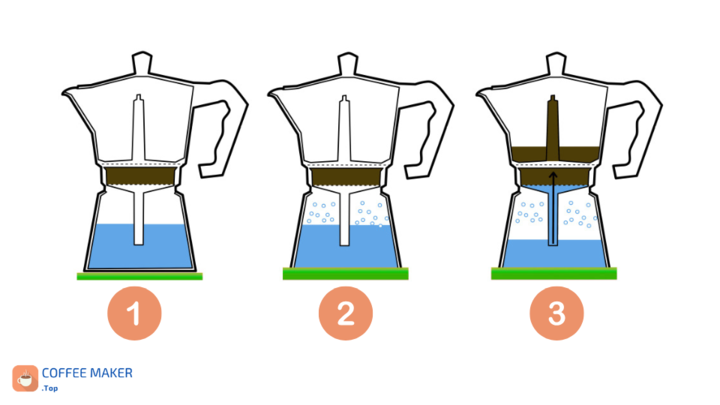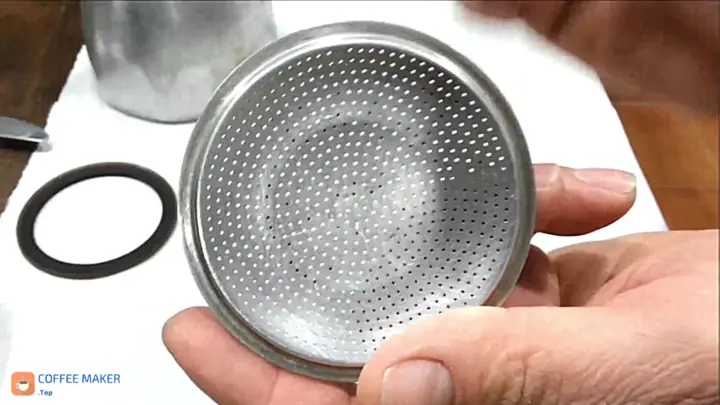Most users of a Moka pot fall into the error of thinking that, as it uses a simpler technology than other coffee makers, they can forget about its cleaning and maintenance. However, this is a big mistake.
Whether you are an experienced user of Moka pots or have just acquired your first coffee maker, here I will show you how to clean and maintain your Moka pot so that it lasts like new forever.
How to use a Moka pot
Before we dive into cleaning and maintenance, you should know and understand how a Moka pot works and should be used. You can maintain it properly when you know all the parts and how each interacts with the others and with the coffee.
Steps to prepare coffee with a Moka pot:
- Fill the water tank with boiling water. Fill just below the safety valve because if you exceed this level, the valve will not work. Remember that the safety valve on Moka pots releases steam in case of overpressure.
- Add the ground coffee in the funnel up to the top edge. Remember not to compact this coffee and use a finger to level the coffee. The coffee grind should be medium-fine.
- Place the funnel with the coffee on top of the lower body of the coffee maker, being careful not to burn yourself and making sure that it fits well; otherwise, the Moka pot may not brew the coffee well.
- Close the Moka pot using a cloth and make sure it is hermetically sealed. The standard closing mechanism consists of screwing the two parts together. Never force or pull on the handle of the Moka pot during this step, or you may break it.
- Finally, place the Moka pot on the stove, or plug it into its base if it’s electric, to heat the water. Waiting times vary depending on the model of the coffee maker and how hot the water you use is, but normally you will have your coffee ready in one or two minutes.
In the drawing below, you can see the simplicity of the operation of a Moka pot. The water in the lower tank is heated until it turns into steam, and then this steam rises through the ground coffee, changing its state to liquid again and reaching the upper compartment in the form of coffee:

Basic safety measures
When using a Moka pot, these basic principles and safety recommendations should be remembered (or known to exist).
The safety valve on Moka pots has a special, well-defined function: it releases steam to reduce the pressure in the event of overpressure inside the coffee machine. Without this safety valve, Italian coffee pots could explode.
These are my best safety tips:
- If a jet of steam were to come out of the valve, it would do so at a very high temperature, so the valve should always be facing the wall, never towards you, where it can reach the user or anyone passing by.
- If you want the safety valve to work properly, remember always to leave the water level below the valve.
- You must not use the Moka pot to boil water, prepare infusions or other beverages other than coffee. Therefore, do not put ingredients other than ground coffee in the filter.
- Never open the coffee maker while it is hot, as the pressure may suddenly release and splash you with hot water or coffee. Cool the coffee maker under water before opening it, or wait for it to cool down.
Related: Why do coffee machines explode?
What should I do if the safety valve starts to release steam?
If the safety valve starts to release steam, this means that the Moka pot is overpressurised (i.e. the internal pressure has exceeded a certain safety limit). You should immediately remove it from the heat, turn the valve towards a wall and let the coffee maker cool down.
If overpressure has been created in the boiler of the Moka pot, it is because the steam was unable to rise through the funnel, through the coffee into the upper compartment.
- With the brewer cold, check if you put too much coffee in the funnel or compacted it. You can see this by touching the coffee residue with your fingers; if you can sink your fingers in, this would not be the problem.
- If too much coffee or compaction is not the cause, look at the funnel filter or the flat filter, these could be clogged and not letting the water vapour pass upwards. If you look through them towards the light, you should be able to see clearly.
- These two problems ruled out, the next thing to look at is the valve itself, which may be clogged and releasing steam when it shouldn’t be.

How to clean an Italian Moka pot
Cleaning a Moka pot is not as easy as you might think, but as a summary, I will tell you that you should always use low heating when brewing coffee with your Moka, clean it daily and always keep it dry.
- Many Moka pots are made of stainless steel, so please do not wash them with bleach or abrasive products, as this will damage the steel. Use only hot water and mild soap.
- Clean the internal components: filters, reservoirs, and coffee funnel daily with plenty of water. If they become clogged, the Moka will not work properly because, no matter how much pressure there is, the vapour will not pass through the coffee.
- Dry the machine thoroughly with a cloth after washing, and do not leave it to air dry. If necessary, use a kitchen towel to prevent moisture from remaining inside the machine, which could lead to bacteria and corrosion over time.
- Press your finger on the ball in the centre of the safety valve. If it moves, the valve is clean and in perfect condition. If it is blocked, it must be cleaned before use.
- If your coffee maker is blackened on the outside, you may want to read this article to try to remove the ugly stains: how to clean a burnt Moka pot.
Here’s an interesting video that shows you in more detail the process you should follow in cleaning your Moka pot when it’s already filthy:
How to cure an aluminium Moka pot
First of all, we remind you that curing any aluminium utensil is necessary to prevent food from absorbing metallic aromas and deteriorating over time. It is a hygienic practice that must be constant, not a one-off event.
Aluminium Moka pots usually have a layer of oil or grease (invisible, of course) to protect them. Over time and with use, this layer disappears. Curing our Moka pans will help to restore and polish this protective layer.
The process can be divided into three steps:
- Thoroughly cleaning the Moka
- Cure the coffee machine.
- Rinse and dry.
The time needed: 30 minutes.
Here is a step-by-step explanation of how to cure a Moka Pot:
- Clean the coffee maker thoroughly. We do this with hot water and mild soap.
- Remove all traces of dirt. Use a regular sponge (non-abrasive, non-scratching). We repeat the process until we are sure that no dirt is left on the surface of the coffee maker.
- Rinse and dry the Moka pot thoroughly again. We must dry it with a very soft cloth or a kitchen towel.
- We begin the curing process: preheat the oven to 180ºC.
- Grab a cotton ball and dip it in olive or coconut oil (If you don’t want cotton, you can use kitchen paper).
- Spread the oil well over the entire surface of the Moka pot. Ensure that the oil (fat) penetrates every tiny crack on the surface of the coffee machine.
- Dismantle the plastic parts or elements that cannot be exposed to these temperatures.
- Put the Moka in the oven for 10 minutes.
- Take it out and let it cool down. After it has cooled down, you should wash the coffee maker as you usually do (remember to use a sponge or scouring pad that does not scratch).
After drying it for the last time, the oil will have created a new protective film of grease. Your coffee maker is now cured.
General recommendations for use
The following tips are designed to extend the life of your Moka pot and not spoil it unnecessarily. If you follow them to the letter, you can be sure of having a coffee maker for many years to come.
- Always use filtered water if the tap water in your city is too hard.
- Never set fire to maximum, but rather to medium intensity.
- If your stove is a gas cooker, ensure that the flames do not stick out the sides of the Moka pot.
- Ground coffee should be medium-fine in thickness.
- You should never tamper it once into the filter.
- Do not try to put substitutes, coffee extracts, infusions or any other ingredient into the filter.
- Check the rubber gasket frequently, and replace it every year.
Related: Kopi Luwak coffee or Civet coffee.
